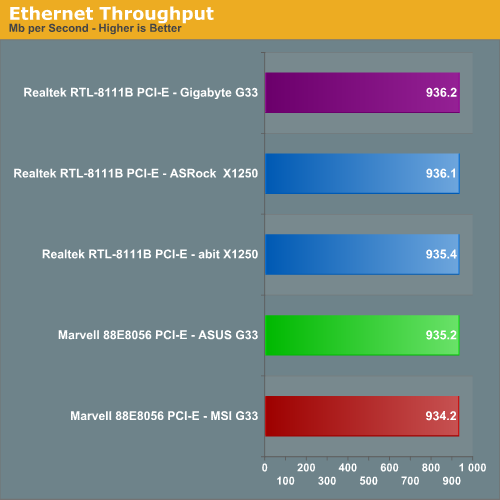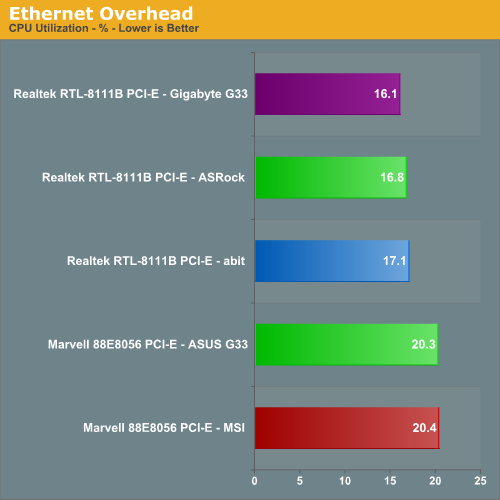µATX Part 2: Intel G33 Performance Review
by Gary Key on September 27, 2007 3:00 AM EST- Posted in
- Motherboards
Ethernet Performance
The current motherboard test suite includes LAN performance measurements. All of these boards utilize PCI or PCI Express based controllers with the only difference being the supplier of the core logic.
The Windows 2000 Driver Development Kit (DDK) includes a useful LAN testing utility called NTttcp. We used the NTttcp tool to test Ethernet throughput and the CPU utilization of the various Ethernet Controllers used on the Intel motherboards.
We set up one machine as the server; in this test, an Intel system with an Intel CSA Gigabit LAN connection. Intel CSA has a reputation for providing fast throughput and is a logical choice for our Gigabit LAN server.
On the server side, we used the following Command Line as suggested by the VIA whitepaper on LAN testing:


Both the CPU utilization and throughput performance favors the Realtek Gigabit controllers with the Gigabyte implementation offering the best combination. However, the differences are slight and will not be noticed under normal operating circumstances.
The current motherboard test suite includes LAN performance measurements. All of these boards utilize PCI or PCI Express based controllers with the only difference being the supplier of the core logic.
The Windows 2000 Driver Development Kit (DDK) includes a useful LAN testing utility called NTttcp. We used the NTttcp tool to test Ethernet throughput and the CPU utilization of the various Ethernet Controllers used on the Intel motherboards.
We set up one machine as the server; in this test, an Intel system with an Intel CSA Gigabit LAN connection. Intel CSA has a reputation for providing fast throughput and is a logical choice for our Gigabit LAN server.
On the server side, we used the following Command Line as suggested by the VIA whitepaper on LAN testing:
Ntttcpr -m 4,0,‹server IP› -a 4 -l 256000 -n 30000Ntttcps -m 4,0,‹client IP› -a 4 -l 256000 -n 30000

Both the CPU utilization and throughput performance favors the Realtek Gigabit controllers with the Gigabyte implementation offering the best combination. However, the differences are slight and will not be noticed under normal operating circumstances.










26 Comments
View All Comments
sprockkets - Friday, September 28, 2007 - link
Sad how an AMD 7050 board can be had for $80, $40 cheaper with the same features. It is the premium you pay for having dvi.Oddly enough too is that the Gigabyte board you quote doesn't use all solid caps yet the lower end board does. And of course, they didn't bother with solid caps on their new AMD boards period, cause "AMD is second tier."
tayhimself - Thursday, September 27, 2007 - link
Preposterous!! Why do they even bother making this junk without DVI. More and more I find that I don't want a leet board that overclocks 100 Mhz higher but a stable board with the right features. -sigh-8steve8 - Thursday, September 27, 2007 - link
and on top of it, these igp's are not suited well for gaming or videos,,, (the two applications where you may not notice the difference between a digital and analog interface), so they will be used for text/office work... an application where the discrepancies in the user-experience of analog vs digital interfaces with an LCD are undeniable.again, great article.,, but in the end, I sort of wonder why waste ur time exploring these boards when your time is better spent on solutions that deserve our money?
JarredWalton - Thursday, September 27, 2007 - link
I think both of those G33 + SDVO models launched long after Gary had started work on this uATX stuff. Good to see that some people are including the necessary chip, as uATX without DVI is simply unacceptable. Unfortunately, testing some of this stuff takes a lot more time than we would like. We're working to address that, however.jenli - Thursday, September 27, 2007 - link
I would love to see a review of motherboards with igpthat can be converted to raid servers by using the lone
pcie 16x slot.
Have fun,
CK804 - Thursday, September 27, 2007 - link
I'm doing exactly what you mention with an Intel DG965RY. I have an Areca ARC-1210 fitted in there with 3 320GB WD Caviar SE16s in RAID 5.